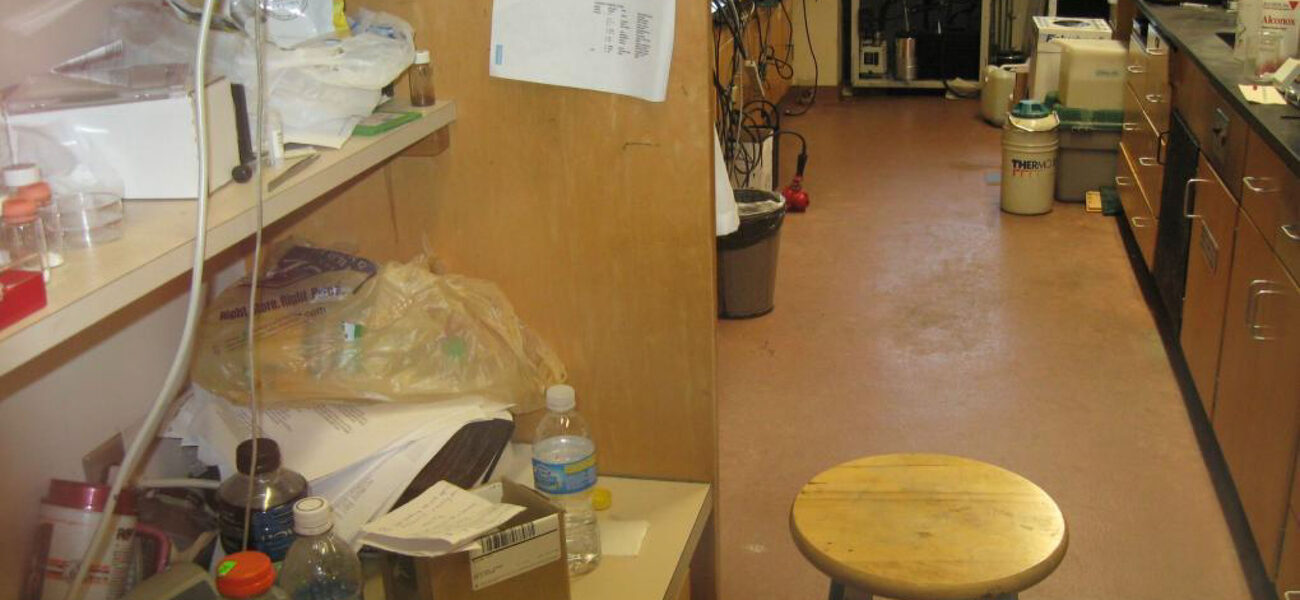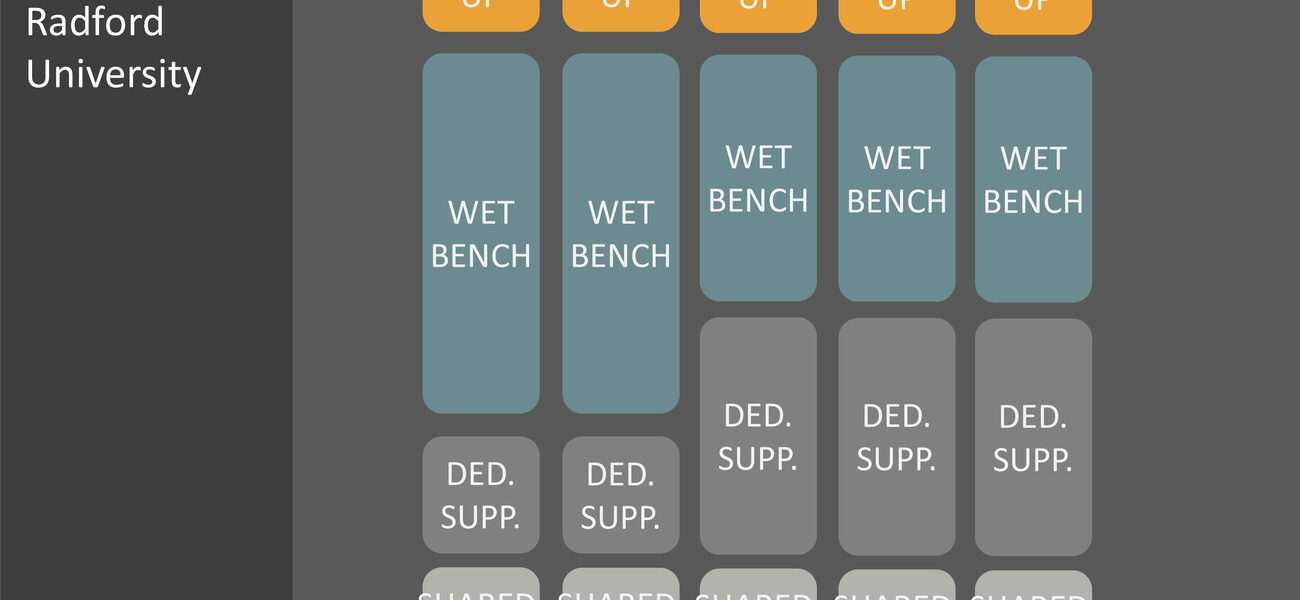Research universities and liberal arts colleges are taking a closer look at how they apportion lab space to provide the best research environment for faculty and an optimal learning atmosphere for students, while adhering to safety protocols, reducing costs, and adding institutional flexibility.
“Laboratory space is much more than laboratory bench, and the way faculty members perceive space is different than what students need,” says Charles Kirby, academic design and planning principal at EYP Architecture & Engineering. “Faculty members know what they are doing in their laboratory space, and students are looking to discover their personal scientific passions.”
Institutions can accommodate both researchers and students by strategically allocating lab space fairly and efficiently. Incorporating flexibility into the lab configuration helps the institution adapt to ever-changing research requirements and student interests.
EYP has noticed an evolution in lab configuration at both research universities and liberal arts colleges, with the presence of three distinct research models: single researcher, paired researcher, and multiple researcher. These configurations have evolved in response to the need to develop long-term spatial solutions that provide institutional flexibility, promote a research community, and provide the best use of institutional resources.
Single-Researcher Model
The single-researcher model has been in use the longest, especially at undergraduate liberal arts colleges. It is physically separated from other labs and is intended for use by one faculty member who has complete control over his or her space. The lab allocation for each faculty member is contained within four walls and is typically equal for all researchers.
“The single-researcher model is still being utilized, although less often for two reasons,” says Kirby. “It limits institutional flexibility and it can impinge on the development of a community of research scholars, especially for undergraduate and graduate students.”
Flexibility is limited by the walls between labs and lab customization within. Establishing a research community is inhibited by the lack of faculty and students who can work with other researchers and their assistants. Further challenges include difficulty in obtaining a lab partner among the limited number of co-workers on the research team, and difficulty in accommodating changes in research or personnel without significant renovation.
“This model was selected at the Integrated Sciences Center Phase III, currently in design at the College of William and Mary, to conform to the first two phases of the project,” notes Toni Loiacano, project architect at EYP. “Maintaining parity among researchers is important. The biggest modification is the location of the single-researcher labs into a central block that can be easily modified over time as research needs and personnel change.”
Paired-Researcher Model
This model is becoming more prominent, primarily at the undergraduate level in liberal arts colleges, but has also been used at the graduate level. It is an ideal solution when a single-researcher lab is too confined, and a large multiple-researcher lab is not necessary.
“For many liberal arts institutions, the number of researchers with similar interests is limited,” says Loiacano. “The paired model allows for some long-term flexibility and creates labs with improved safety.”
This arrangement enables two researchers with similar interests to easily share equipment and other resources; promotes a small scholarly community for the two researchers and their students; creates institutional flexibility in the amount of space allocated to each researcher to respond to changes in personnel, research, and student interest; and doubles the opportunity to have a lab partner.
Drawbacks include limited flexibility due to the walls between the labs; difficulty in accommodating changes without significant renovation, depending on lab customization; and inhibition of research community due to a limited ability to collaborate with others.
Multiple-Researcher Model
This model helps institutions overcome the drawbacks of the other two configurations. It facilitates a research community with shared bench and write-up space that encourage interaction and collaboration between the researchers and their assistants. It significantly increases the opportunities to have a lab partner, and it enables institutions to react to changes and quickly modify the amount of space allocated to a researcher. However, researchers may feel they have a lack of control over their research space and equipment, and the large, open lab may feel impersonal or loud.
Despite a few shortcomings, the multiple-faculty model is modern because of its flexibility, and popular because it enables the development of research communities and provides institutions with long-term flexibility in their research facilities.
“This model has not been used at many liberal arts colleges because administration and faculty are most familiar with the single-researcher model,” notes Loiacano. “As they become aware of alternative models, these institutions are excited to explore ways in which space can be more flexible and in better alignment with their institutional focus on enhancing the student experience.”
Radford University intends to use this configuration in its new labs, which are in the early construction phase, in order to provide a lab where chemists, biochemists, molecular biologists, and many other disciplines have space of their own in an environment that nurtures collaboration and enables easy adaptation to meet changing research needs.
The model makes it easy to:
- Plan and design research labs based on a flexible module;
- Group the allocation of multiple researchers into a single research block depending on the institutional mission and research requirements;
- Differentiate the lab into four types of space, including write-up, wet bench, dedicated support, and shared support;
- Provide dedicated support space for each researcher to control access to equipment, specimens, and other research materials; and
- Create a common write-up space shared by all researchers in the block.
Deconstructing the Lab
Allocation of the four types of space is based on the needs of the researchers and students, which goes hand in hand with determining what research lab model is best for an institution. EYP data shows the average space allocation per faculty member is 650 nsf, broken into 410 nsf for wet bench; 122 nsf for shared support; 62 nsf for write-up; and 22 nsf for dedicated support.
Average space allocation per faculty member in a single-researcher lab is 760 nsf with 583 nsf devoted to bench. The allocation per faculty member drops to an average of 516 nsf in a paired-faculty lab, with 366 nsf being used for bench. In a multiple-researcher lab, the allocation per faculty member is 673 nsf with 379 nsf for bench and a greater amount of space used for shared support (178 nsf ) and write-up (100 nsf).
EYP uses the phrase “deconstructing the lab” to help clients differentiate the four types of lab space. Each space has different requirements and varies in construction costs. Wet bench space is the most expensive and write-up is the least.
“By not building the entire research lab as wet bench space, the overall construction cost can be reduced,” says Kirby.
Although write-up space is the least expensive, it is one of the most important. It provides space for experiment write-up, research team meetings, securing personal belongings, and informal collaboration. The space is also important for safety, security, and community. Locating this space outside the lab, but directly adjacent to it, creates a safe zone for eating and drinking.
The write-up area often acts as a spatial buffer between the research lab and corridors. EYP typically suggests transparent walls between the corridor, write-up, and lab to ensure visibility of the activities within. As a separate space, the write-up can serve as an access control buffer.
Safety and Flexibility
The proper lab design enhances safety and ensures flexibility and adaptability. EYP’s top three safety protocols include having a lab partner to avoid working alone in a lab, leaving food and beverages outside the lab, and being aware of safety equipment locations. Safety is increased by having write-up spaces outside the lab, creating safety stations near the lab entrances, and enhancing visibility of the lab with the inclusion of glass.
Institutional flexibility can be achieved with a layout that enables a researcher’s wet bench space to grow and shrink based on his or her needs, funding, and student interest. Modular layouts that permit the easy modification of the benches, lab services, and mechanical systems are a good choice, says Loiacano.
“The creation of modular dedicated and shared support spaces, or core labs, allows for the thoughtful placement of equipment that responds to the needs of access, control, security, and specialized environmental requirements,” she says. “These spaces should be directly adjacent to the wet bench. Consideration should be given to corridor access for the shared support spaces.”
Lessons Learned
Spatial differentiation in the research lab allows construction costs to be minimized in response to the decreasing need for wet bench space, which is trending downward at liberal arts colleges and graduate institutions.
Kirby and Loiacano say there are important lessons to be learned from the trends. In particular:
- Graduate institutions are learning from liberal arts colleges about the importance of promoting a research community to enhance the vibrancy of the research and improve retention of researchers and students.
- The liberal arts colleges are learning from graduate institutions about the importance of institutional flexibility to provide long-term spatial solutions.
- Research lab allocation is trending downward at liberal arts colleges across all three research lab models.
By Tracy Carbasho
This report is based on a presentation given by Kirby and Loiacano at Tradeline’s College and University Science Facilities 2012 conference.
| Organization |
|---|
|
EYP Architecture & Engineering
|

